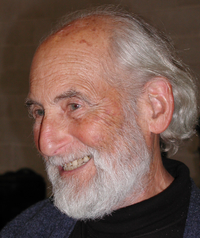 |
Herbert Bishop Keller
by Hinke Osinga
University of Bristol, UK |
In March 2005 DSWeb Magazine had the splendid opportunity to do an
interview with Herb Keller when he visited Bristol to attend the
workshop Qualitative Numerical Analysis of High-dimensional
Nonlinear Systems. Herbert Bishop Keller, who was born in 1925 in
Paterson, New Jersey, turns 80 this year ("Yes, in June... If I last
that long"). Starting at the age of 20, he has been working in
mathematics for almost 60 years and it would be impossible to convey
the entire breadth and depth of his work in one article. This
interview particularly focuses on his contributions in Dynamical
Systems Theory.
| Herb got a Bachelor in Electronic Engineering from Georgia Tech in
1945. "This was a special program during the war years, where you took
three semesters in one year for an otherwise four-year program. I did
it in two years and eight months and so I was only 20 years old then."
Herb got to Georgia Tech as part of the Naval Reserve
Officer Training core program. He was trained as a fire control
officer and he was on a battleship preparing for the invasion
of Japan. There is a certain matter-of-fact-ness about it: "I got my
diploma, and the next day I got married, and the next day I was off to
war." From this point of view, one can understand the
elation Herb felt when the bomb was dropped: |
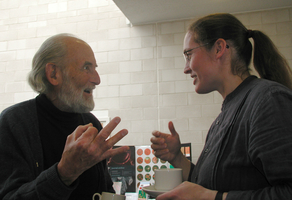 |
Herb to Hinke: "I
got my degree and the next day I got my comission as an Ensign in the Navy, and the next day I got my Georgia peach!"
(March 24 2005, photographer Bernd Krauskopf) |
| it meant he could go home. "They had a point system:
you could get discharged as soon as you had enough points." However,
when Herb had collected the required number of points a few months
later, he was told that he couldn't possibly leave! "I was their only
qualified catapult officer, they couldn't lose me." As suggested by a
fellow officer, Herb put a message on the notice board `Catapult
class, 8am Monday morning' and, indeed, four young men showed
up. "They were all from Annapolis, and one of them was Jimmy Carter!
After two weeks of training them, I could go home." |
In 1946 Herb was back at Georgia Tech and trying to decide what to
do. His two-year older brother Joe was by then a Faculty member at the
Institute for Mathematics and Mechanics at New York University,
which later was to become the Courant Institute of Mathematical Sciences. "I was
interested in Engineering and Physics, so naturally I was good at
Mathematics, but I had never thought about a career in
Mathematics. Through my brother I began to believe that Mathematics
might be interesting." Joe arranged for Herb to meet
Courant. Obviously, an interview with Courant himself was a serious
matter, and Herb decided to wear his Navy Whites. "I had worn that
uniform only twice before, when I tried it on, and when I got
married. It seemed appropriate to wear it again." It is unclear
whether the uniform did it. Courant certainly was not much impressed
with Herb's mathematical skills. "At one point he looked up and down
the big windows in his office and asked: `Do you know how to wash
windows?' But he hired me anyway and, fortunately, he found something
else for me to do!" So that was that. Herb went to New York and
studied for his Master's, which he got in 1948.
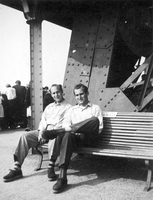 |
Herb wrote papers with his brother on scattering theory
and the reflection and transmission of electromagnetic and sonic
waves. Part-time he also taught
at Sarah Lawrence College in Bronxsville, New York.
"There were 360 mostly wealthy and good-looking girls at this school,
and I was the Math Department. That was a pretty nice job." As Herb
was looking for a topic for his PhD, he realized that he should not
work too closely with his brother. He decided to move away from
scattering theory into computing. "I decided to become a Numerical
Analysist." He wrote a thesis On systems of linear ordinary
differential equations with applications to ionospheric
propagation with Wilhelm Magnus as his advisor and received his
PhD in 1954. From then on, he was a full-time member of the faculty at
NYU. |
| Joe and Herb Keller
on la Tour Eiffel in 1948. |
NYU was an extremely active place. The Institute officially became
the Courant Institute in 1960, with Niels Bohr as the dedication
speaker. "Everyone from Europe who traveled to the US came through
Courant. The institute was well known and I got to meet lots of
people." In the late 1950s NYU bought the third UNIVAC. This
is a 1000-word memory mercury delay line computer, the first
commercially available high-speed computer. They founded the AEC
Computing and Applied Mathematics Center, of which Herb was the
associate director and Peter Lax was the director. "This was the
beginning of Scientific Computing. I think I was very fortunate to be
getting into the numerical business at the right time. Numerical
Analysis really took off. The main problem was how to solve big
systems on small computers. It is changing now, because there is so
much good software. We didn't even know the term
software!"
Research in the early 1960s always had a strong military
flavor. "We had the cold war with Russia. We wanted to know how to
protect people from bombs." Together with Bob Richtmeyer, Herb set up
a research group working on nuclear reactions and the effects of
atomic weapons. "We were interested in Mathematical Physics in much
the same way as Los Alamos, but our stuff was not classified. We
worked on the theory of nuclear reactors for naval power
reactors. These were diffusion problems and transport problems. It was
all done numerically."
| At the same time, Herb was interested in fluid flow
problems. "At Courant there was lots going on about fluid flow. You
simply couldn't help being part of it. It really was the area where I
started to work on computational things." He studied Von Karman
swirling flow between rotating disks, Taylor-Couette
flow, flows in channels and over airplane wings. "Oh yeah, and
satellite re-entry problems. That is simply the flow around a sphere
when entering the atmosphere at hypersonic speeds." |
 |
| Herb and Joe
Keller at Iguassue Falls in Brazil, 1985. |
Developing a taste for Dynamical System Theory
At some point, Herb started working with Ed Riess, who was
interested in solid mechanics at Courant, on the buckling of spherical
shells and rods and so on. "We treated it as an equilibrium
phenomenon, while it was a bifurcation problem. But we didn't know that
at the time. We realized it had dynamics, but didn't do much about
it."
This was also the time when Herb moved from the Courant Institute
to the department of Applied and Computational Mathematics at Caltech. He
had visited Caltech in 1965, but went back to NYU in 1966. "Courant
came to see me and told me that it would be so much better for me to come
back to NYU. I agreed with him. I mean, they had much more powerful
machines than at Caltech. But when I came back to New York, I knew it
was a mistake and I left for Caltech again in 1967 and have been there
ever since."
 |
|
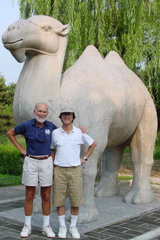 |
| Herb Keller and Tony Chan (right) in China. |
At NYU, Herb had alternated teaching Numerical Analysis with Eugene
Isaacson, who was quite a bit older than Herb. Wiley asked them
whether they were interested in writing a book about it from the
lecture notes. "We had a really good collaboration going, working on
this book together. This continued while I was at Caltech, which is
quite something, because we didn't have email at the time. I remember
writing the preface of the book. I found it really difficult and
wanted to get it over with. But when I sent it to Eugene, he responded
that it was terrible and had all sorts of suggestions on how to change
it. That's when I decided to work in my secret message. Do you know
what an acronym is? You go and figure it out. And when you think you
should give up, keep on reading! When Eugene saw it, he never
complained again." [When Herb told me this, we were enjoying a
sparkling Chardonnay at a nice restaurant, and I couldn't wait to get
back to my office and read the preface. It's worth it.]
As Herb worked on the book with Eugene Isaacson, he got too carried
away on two-point boundary value problems. "It was too much material
and I decided to write a monograph on it separately. The techniques
explained in that book really were the start of the continuation
setting." At Caltech, in 1967, Herb learnt about Lyapunov-Schmidt
methods, which made a big impression on him. It was then that he
started doing serious bifurcation theory and path continuation. "The
real turning point only came in 1976, when I was asked to speak at the
Advanced Seminar on Applications in Bifurcation Theory,
organized by Paul Rabinowitz and Mike Crandall. The army had a big
center for research at the University of Wisconsin and they organized
a series of meetings every year with a book for each. In my paper
"Numerical Solution of Bifurcation and Nonlinear Eigenvalue Problems"
for this book, I invented the term pseudo-arclength
continuation. It is my most popular paper ever. Rabinowitz was
very thankful, because the popularity of my paper meant that his book
was very popular."
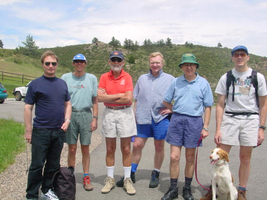 |
|
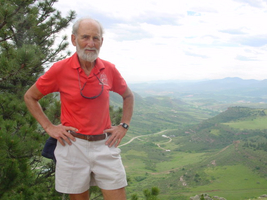 |
| Stig Larsson, Simon
Tavener, Herb Keller, Alastair Spence, Ridgway Scott, and Don Estep
hiking in the Rocky Mountains outside of Fort Collins, Colorado, May
2001. |
While research in Applied and Computational Mathematics at
Caltech, which grew out of Aeronautics, was primarily
focused on Fluid Dynamics, Herb brought in a strong numerical
component. He built up a group of people working in Numerical
Analysis, including Heinz-Otto Kreiss, Bengt Fornberg, Jens Lorenz,
Tony Chan, Jim Varah, Eitan Tadmore and others. However, the core
group at ACM was built by Gerald Whitham (a student of Lighthill's),
and included Philip Saffman (who had worked with G.I. Taylor), Paco
Lagerstrom (a topologist by training who worked on asymptotics in
Aero), Julian Cole (also from Aero), Don Cohen (a student of Joseph
Keller), and, of course, Herb himself. "In addition, I've had tons of
excellent students and postdocs. You know,
if you get garbage in, you get garbage out, but if you get good
students in... It was a pleasure! Yes, in a sense I was lucky, being
at such fantastic places and all that. I was influenced by the many
good people around me. However, you cannot fake it in this
business."
Retirement
In contrast to many other countries, there is no longer forced
retirement in the US. In 1983, an old senator from Florida who himself
was in the 90s, passed a law that one should not force people to
retire just because of age. As a transition period, it was decided
that in the following ten years, one must retire when reaching the age
of 70. "I was lucky. My brother turned 70 just before the end of those
ten years, but I didn't."
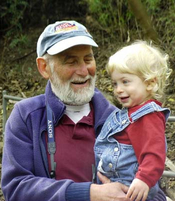 |
For many of the younger mathematicians, especially those
who are still looking for a permanent job, it can be frustrating to
see grey old men (mostly, isn't it!) sitting on precious academic
posts. Herb ponders the possible benefits of forced retirement: "In
fact, we did have a discussion at Caltech about how to get rid of the
dead wood, but we decided that, at Caltech, we did not have to worry
about it." Caltech has an appealing early retirement program,
offering a two-year scholarly leave with full pay and no teaching
(like a two-year sabbatical), at the end of which one should
retire. "I think that good people do not hang on by the skin of their
teeth. When they feel they do not pull their weight as compared to the
people around them, they will pull out." |
| Herb Keller with his grandson Milo at San Diego Zoo. |
| Herb retired from Caltech in 2001. He is now a research
scientist at UC San
Diego and also kept his office at Caltech, which he also visits
regularly. "Aging has effects on your research. You need to do lots of
calculations and I find it harder to do. It used to be fun, but it is
not as much fun anymore and it certainly does not go as fast." Herb
also got tired of teaching. "It is a big commitment and I certainly
was not very good at it. I probably could have been more stimulating."
Caltech annually awards the Feynman Prize for Excellence in
Teaching. The winner is chosen by the students, and the prize consists
of a cash award of $3,500 and an equivalent raise in the winner's
salary. |
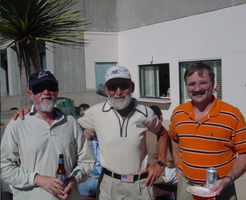 |
| Jim Bunch, Herb Keller,
and Randy Bank at UCSD, drinking beer. |
| Herb has never won that prize ("Oh no, I didn't even
come close!"), but he did ask advice on teaching from Harry Gray, the
Beckman Professor of Chemistry, who is a very popular teacher." He
told me that you should never start lecturing straight away. The first
five to ten minutes the students are not ready for you
yet. Furthermore, they cannot concentrate for more than 15 minutes and
it is impossible to have them absorb more than one new idea in a
lecture. Well, I think he had quite a low opinion of the students, but
he worked very hard at teaching professionally. I never thought about
it. My concerns were how to best present the material and how to
present the proofs." There is a second aspect: the rate at which the
course content changes is often slow compared to the changes in
technology. "You work so hard on getting the course material, you
cannot keep up, certainly not if you ever want to get any research
done." |
"I must say that it feels great to be retired. We old guys thought
we were irreplacable, but we're not. We have been replaced and the
young mathematicians are good. However, I do miss having
students. That I miss most."
Addicted to cycling
Those who know Herb well know that he hardly ever goes anywhere
without his bicycle. "I started cycling rather late, in early 1981 or
so. After my divorce I wanted to keep more contact with my son. He was
at UC Davis and
everyone bikes there, so..." After Herb had been invited to
Oberwolfach, he decided to do a big bike tour in Germany and asked his
son to join him. What should have been a fanastic vacation ended
dramatically when Herb could not make the turn on a downhill slope and
ended up head first in a lumber yard. "It must have been terrible for
my son. His first bike tour with his dad and then I had this dreadful
accident." Herb spent one week in a hospital in
Villingen-Schwenningen. Sebius Doedel [Sebius is enjoying the same
Chardonnay in this restaurant] remembers the event quite well, because
he paid Herb a visit at the hospital. Sebius tells us how he came to
the hospital and asked the nurses where he could find Herb Keller. The
nurses immediately knew who he meant, because Herb was their most
honored guest: "Ah, der Herr Keller! Der ist mit einem Helikopter
eingeflogen!!"
Despite this bad accident, Herb has kept cycling ever since. He has
also had many other bicycling accidents, but none as remarkable as
this first one. "It cured my eyesight! For 30 years I had glasses,
even bi-focals, but I haven't worn glasses since."
Bristol, April 2005.